Finally! I’m able to publish something! Today is August 23rd. This post was written on August 10th. I don’t know when I’ll be able to publish again, but just know that I send them out just as quickly as I can. : )
Today was quite a whirlwind of activity, so the post will be a bit longer. Well, OK. A lot longer. We started out about 8:30am and got back home 14 hours later!
It will also be a bit educational, so read on if you like to learn tidbits of new information, or just browse the pictures and fly through it. 😊
First stop – Fort Anne National Historic Site
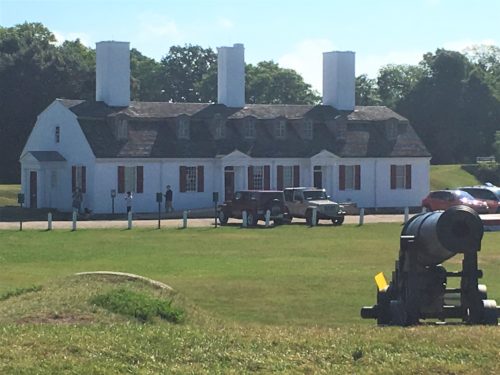
This is the only original building that’s left, but it had to be partially reconstructed
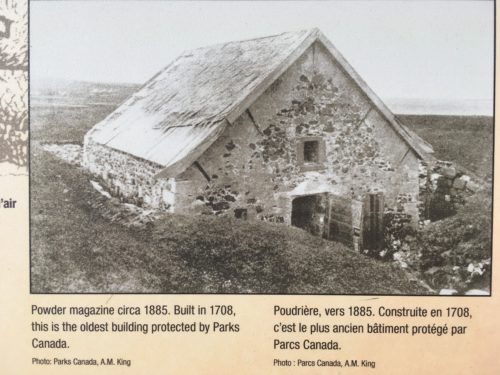
This is a picture that was taken in 1885 of the powder magazine. It too had to be partially reconstructed. See next picture.
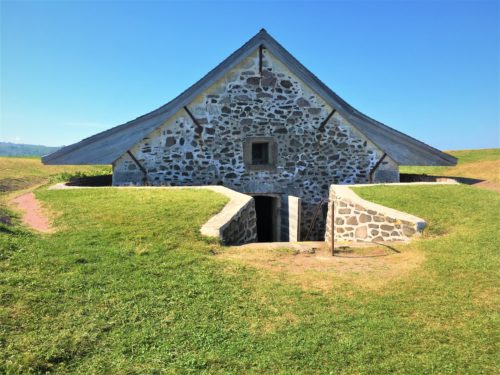
This is Canada’s first operated National Historic Site, so designated in 1917. What that means is that in addition to it being Canada’s 150th birthday, it’s also the 100th birthday of their Parks system.
Fort Anne was one of the most contested places in North America. It was the site of more than a dozen battles between the British and the French during the 16 and 1700s and it changed hands 7 times. The Mi’kmaq (which I’ve sorely neglected in my posts) were already here, and there were also Acadians. These last two groups just wanted everyone to get along. French and English royalty just wanted to lay claim to the territory.
Let’s start with just a snippet on the Mi’kmaq. We’ve seen info on them during most of our stay in Nova Scotia. Why I haven’t mentioned them before now is beyond me. They are a First Nations people indigenous to Canada’s Atlantic Provinces and the Gaspe Peninsula of Quebec. Others today live in Newfoundland and the northeastern region of Maine. They liked the Acadians and were very helpful to them. They tried to be nice to the French and British, but just like in the US, eventually they weren’t welcome in their own home.
The Acadians are the descendants of French settlers who came to North America beginning in 1604. Most of them originated from the western part of central France. 1604 is before Jamestown (The English landed in Jamestown, Virginia in 1607) and even before the Mayflower landed in Cape Cod Massachusetts. That wasn’t until 1620. (So how’s your American history?? Did you remember these dates?)
So. The French and Mi’kmaw are in Nova Scotia and getting along fine until 1613 when an expedition from Jamestown, Virgina (the English) burned the Port-Royal settlement (that’s another place we visited today). That’s when all the fighting started, and the vacillating between French and English control of the area.
Once the British established rule, they were convinced the Acadians would serve as spies for France, so in 1755 almost all of them were deported for refusing to swearing allegiance to England. And that’s how some eventually ended up in Louisiana. Their homes and even their belongings were burned up. In time, some of them returned to the area and joined those few who managed to escape being forced out.
The Fort is laid out much like the Citadel in Halifax. As previously mentioned, they have one remaining building and a powder house from 1708. There were some very interesting artifacts in the building/museum and a gorgeous huge needlework tapestry depicting the heritage of the area. I can’t believe I didn’t take any pictures of it!! It took more than 100 people over 1,000 hours! And that’s not counting the time it took to design it. Now, I know when you break it down, that’s only 10 hours a person, which doesn’t sound like much, so you’ll just have to trust me (a former needleworker myself) that this was a monumental labor of love!
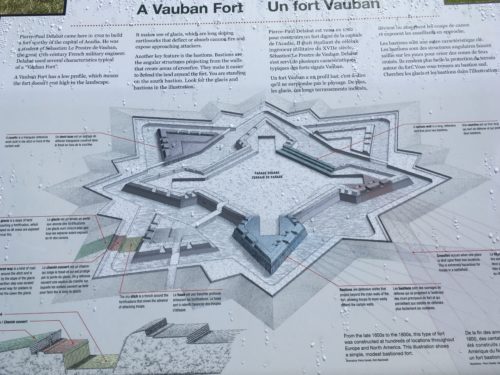
I’m sorry I cut off part of the sides when I took this.
Also, note it’s in French and English, so maybe you can practice and learn some new words! : )
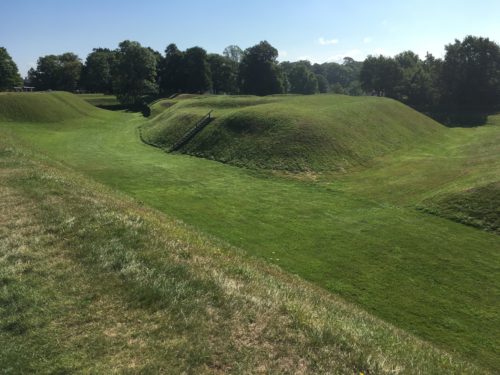
Views from the Fort – –

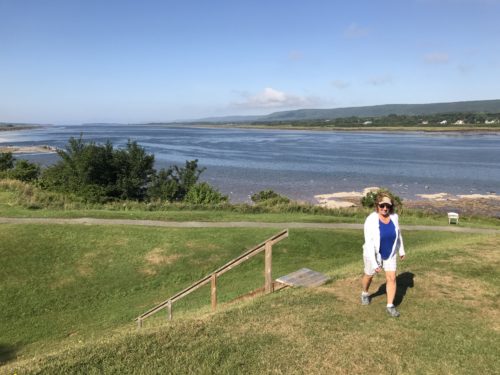
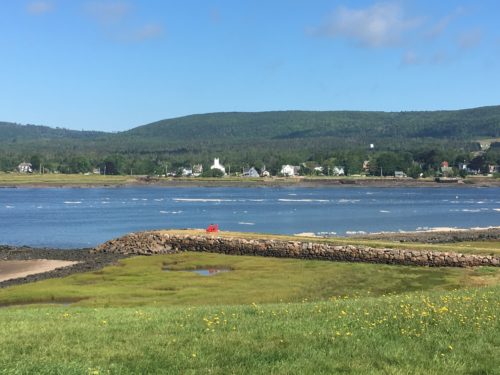
For the sesquicentennial, Canada put pairs of red Adirondack chairs in the parks.

A Persian helmet
cir 400AD
silver and gilded metal
Here, we learned from a Mi’kaw that if you get a porcupine quill stuck in your hand, you should let it go for a couple of days before you remove it. Their quills are designed to go in and stay in. If you pull it out the way it went in, you won’t get it all. After a couple of days, however, it will work it’s way through your hand and once the point is visible, you can pull it out easily. I say – just stay away from porcupines and you won’t have to worry about it!
Stop #2 – Annapolis Royal Tidal Power Project
This place harnesses the energy of the extreme tidal changes in the area and provides the equivalent of power for 4,500 homes.
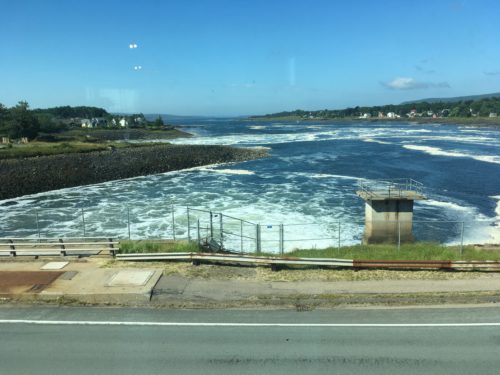
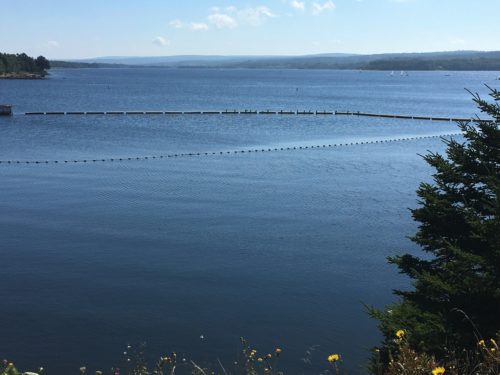
View from the back of the plant
Something we found very interesting was the relocation they do of ospry nests. Because the birds like building homes on top of power poles (as I’ve shown in previous posts), the company has to move them. They relocate an average of 200 nests a year! But never with eggs or babies in them. They say that somehow, the birds manage to find their new locations and return to them year after year. Whaddaya think of that job??
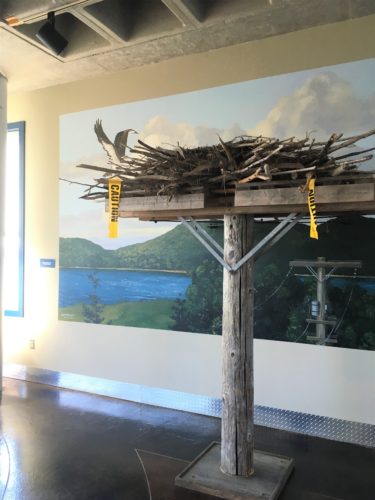
This was in the lobby. Not sure if it’s a real nest or a simulated one.
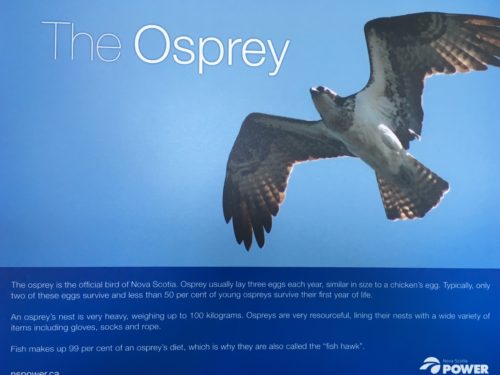
Here’s what an osprey picture should look like. : )
Stop #3 – Melanson Settlement National Historic Site
This was an Acadian village occupied by one entire family, plus one couple who wasn’t related. (do you suppose they felt like outsiders??) It was discovered on a farm in the mid 1980’s. There’s nothing to see now as they let everything return to nature. But it’s protected and they have plaques you can read along a short trail.

A drawing and models of the settlement based on what they found here
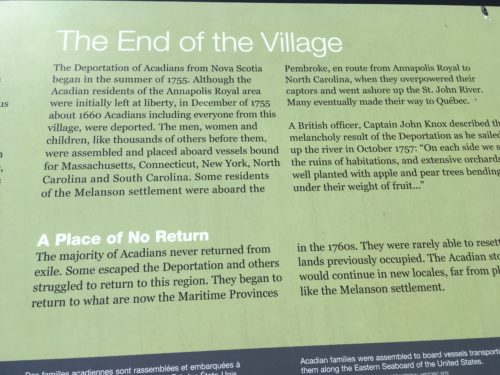
But on the way, we passed a roadside stand selling quarts of fresh blueberries! Yumm! They weren’t as beautiful as the strawberries, so I didn’t take a picture, but they sure tasted good on our brown sugar mini-wheats cereal the next morning! Yes, I said brown sugar. And unless things have changed since June, stores in the Akron area don’t sell them. We like ’em a lot better than the frosted ones. They’re not as sweet. But, I digress.
#4 – Port-Royal National Historic Site

This is a reconstructed settlement from 1605. Samuel de Champlain was one of the explorers who chose the location. (What do you remember about him from your American History? Personally, I remember his name and that he had something to do with the New England area.)
The brains behind the reconstruction was actually an American woman named Herriette Taber Richardson from Cambridge, Massachusetts. She submitted one of the first proposals in 1928 and by 1941, it was completed and opened.
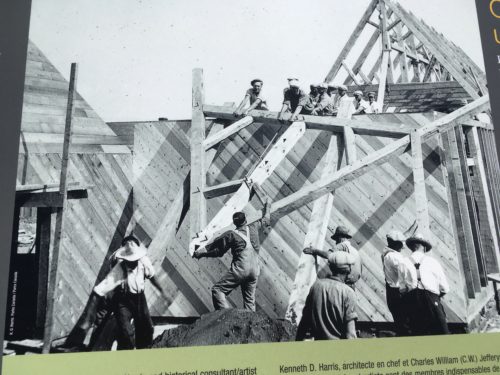
Reminds me a bit of an Amish barn raising.
Because the settlers were having such a difficult go of it, Champlain established a social club in the winter of 1606-07 called “Order of Good Cheer”. Prominent members of the colony would take turns providing a banquet and entertainment (storytelling, etc.) in the governor’s house, wore a special collar and had a procession of men carrying platters into the dining room. BTW – there were no women or children here. No wonder they needed cheered up! 😊
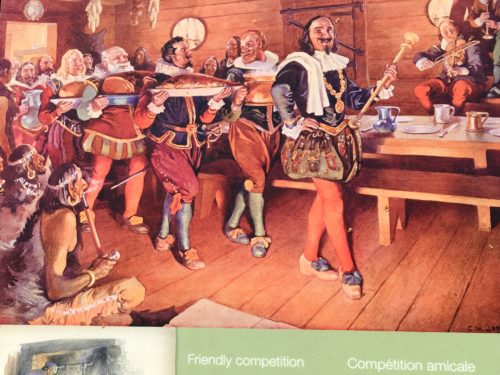
Here’s an artist’s rendition of what they did. : )
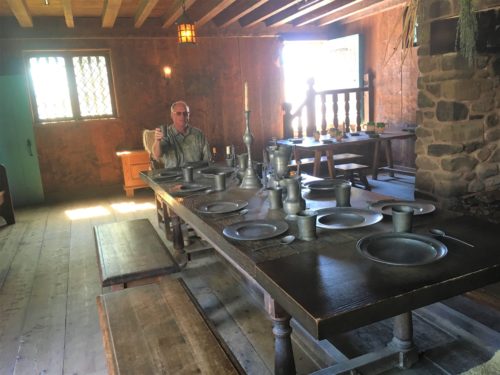
And there he is! The host with the most!
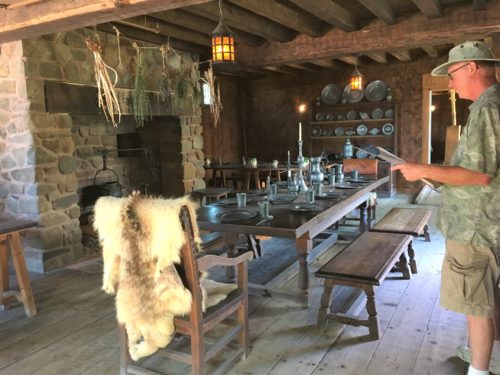
There were lots of rooms that were re-created. Pretty cool!
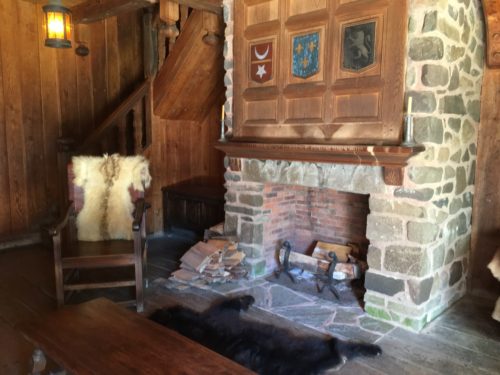
Another room in the governor’s house
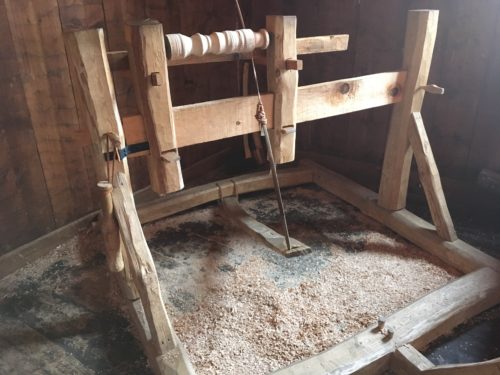
A lathe. They used a strip of leather.
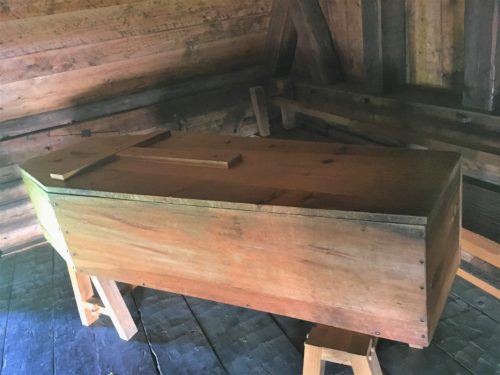
I think you know what this is. : )
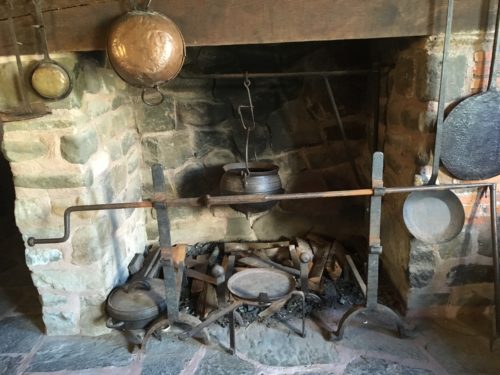
Cooking area. See the spit?
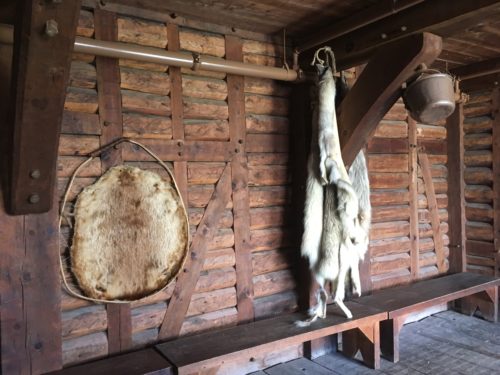
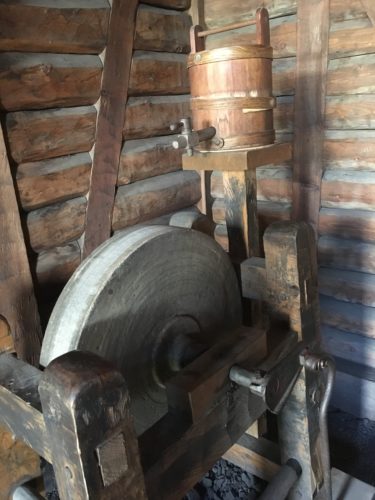
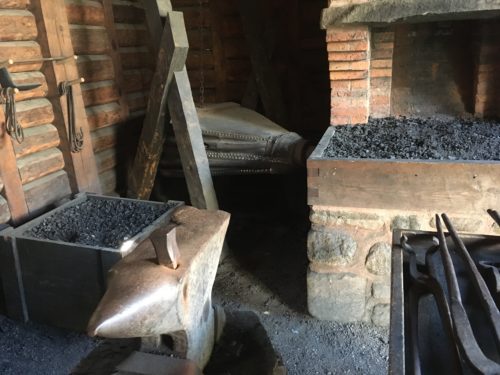
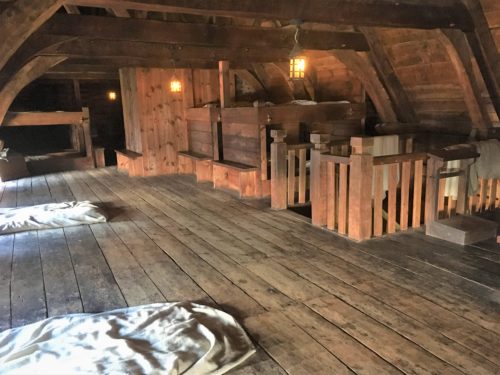
The lower class slept on the floor on the straw mats. The enclosed bunks you see on the right were used for the sick because they were by the chimneys. Also, notice the kneeling bench in the far right by the stairs.
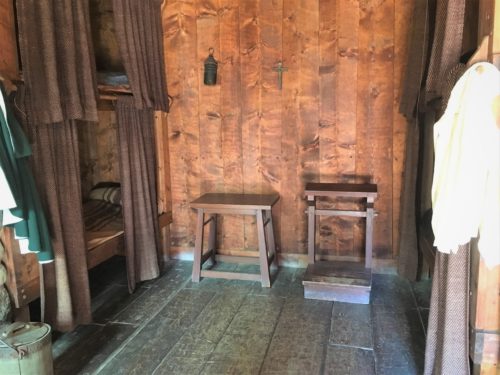
Every home had a kneeling bench for daily prayers.
Oh, that American’s (and everywhere else) would do that today!
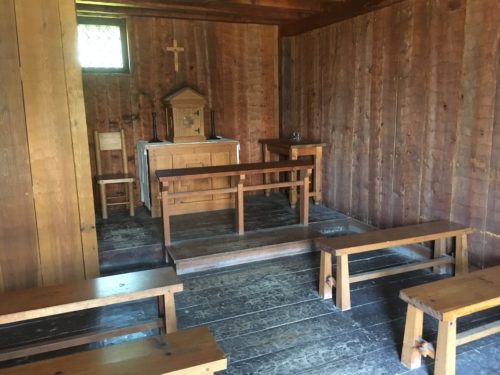
They had a church, and yet they still felt prayer important in their homes.
And now for some more outside pics!
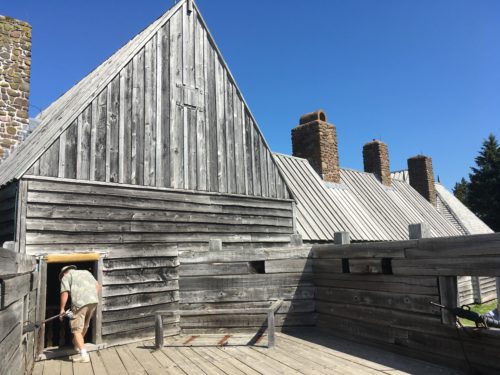
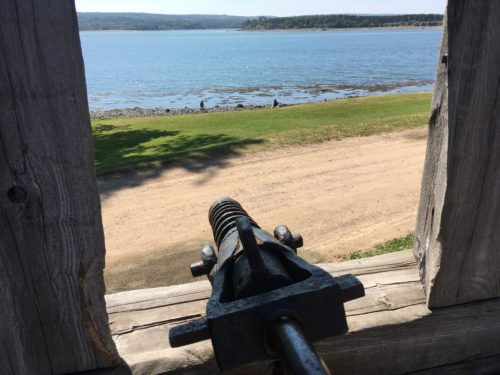

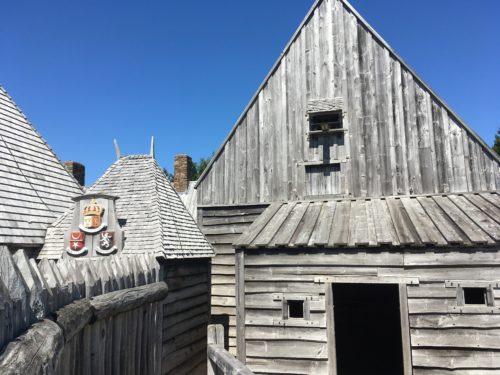
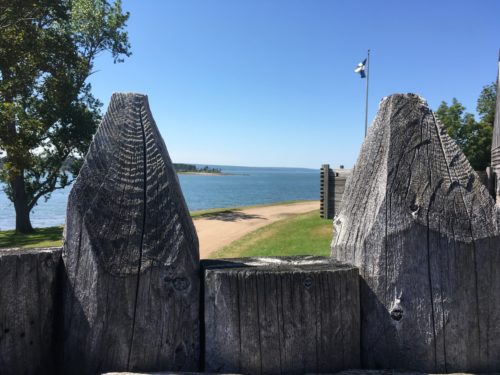

There was a life-size crucifix on the grounds
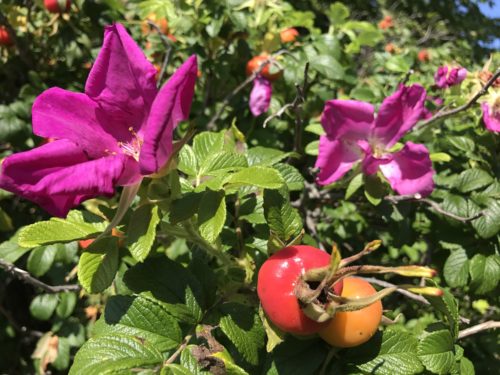
These rose hips seemed to be ‘ripe’ whereas the others I showed you were still green
Stop #5 was a bust! – Blaine had researched (part of which was Tripadvisor) trying to find us a fresh fish market. We were all prepared with a cooler. It was a really weird experience when we stopped at the place he chose, and it turned out – no fish for the public. “All I have is clams” said the guy who looked at us like we had a minimum of two heads!
On to Digby and stop #6 – The Scallop Capitol of the World
The entire time we’ve been in Nova Scotia, we kept hearing about Digby scallops. Now Blaine and I love seafood, so we knew when we got here, we’d be trying these amazing scallops we’d heard so much about. We chose the Shoreline Restaurant for this. Mostly because we were hungry and needed a bathroom. 😊
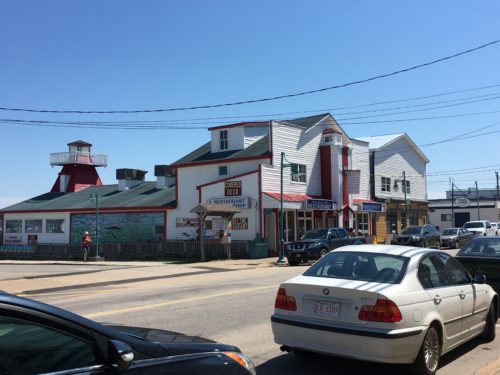
The Shoreline Restaurant
You had to go thru a large gift shop to get to the restaurant. We ate on the porch with a water view. Very nice!
We both ordered their grilled scallop kabobs. While I must say the meal was wonderful (sorry, no picture) and plentiful (10 scallops each, green and red peppers, onions, tomatoes and mushrooms), we didn’t feel like the scallops were any better than any other place they’ve been properly prepared. It’s important to to know that if scallops aren’t prepared properly, they are NOT good.
It was supposed to be the start of Digby’s Scallop Days and we were expecting some kind of festival, but all we saw were a couple of vendors set up along the main street. Maybe Fri-Sun will be more eventful?
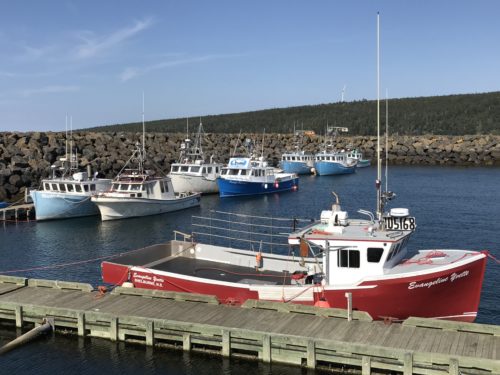
Part of Digby Harbor
There were lots of boats here!
From there, we headed to stop #7 – Ocean Explorations in Tiverton, the location of our whale-watching tour.
We had to take a ferry to get there because there’s this ‘hole’ in the spit. It too cost $7 (like the last one), but this one lasted a bit longer. It was also quite interesting because the water flows back and forth from the Atlantic Ocean to the Bay of Fundy thru this opening, which means there’s this constant fast-moving current that flows in opposite directions depending on the direction of the tide.
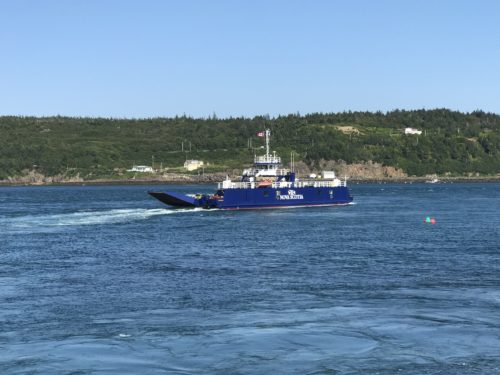
It was really windy, so it was hard to get a good quality picture.

The ferry headed out straight for the opposite dock, turned sideways and powered up, drifting a bit, then made it to the other side. They do this back and forth all day long! Their schedule is supposed to be hourly, but if there’s a bunch of cars waiting on either side, they take more trips.
We got there with about 1 ½ hours to spare before our 5:45pm 2-3 hour tour. Well, hey. It stays light here until about 10pm, so we were good!
So, on to stop #8 – Balancing Rock
This is just down the street. An easy walk down, but a bit more difficult coming back. Besides being downhill most of the 1 mile (one way) trail (you had to get to the water to see it), there are about 235 steps. Good workout after ‘strolling’ all day!
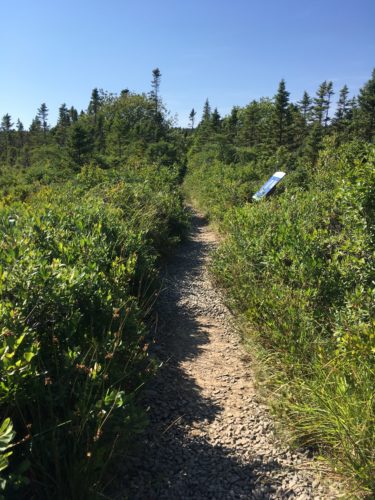
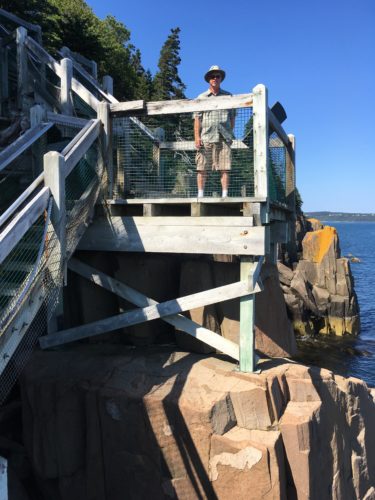
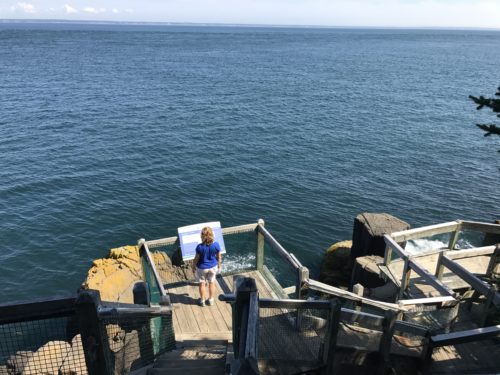
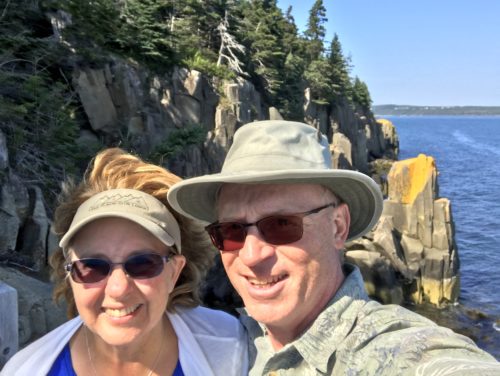
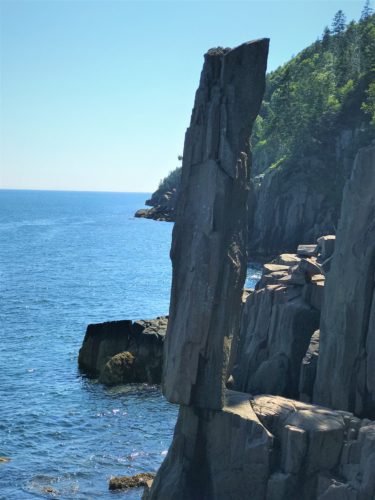
Here it is!
4′ Wide and 20′ Tall
Stop #9 – Ocean Explorations again.
I had researched this company and liked them. They use zodiak boats (low riding motorized boats that hold a maximum of 12 people) and the owner of the company had been in business since the mid 1980’s. He’s also an expert on whales and other critters in the Fundy Bay. It just sounded like a good fit for us.
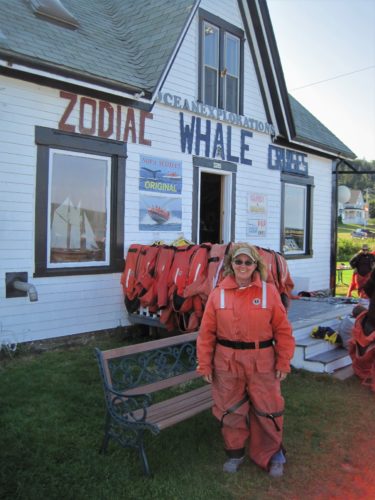
Bundled up and ready to go!
Boy! Was I right! Just riding in the boat was an experience! You skim across the vastness of the Bay, bouncing along over the ripples in the water, heading to who knows where, in search of . . . . what else? Whales! Or dolphins or porpoises or seals . . . And bouncing up and down on your seat. Which is actually the floats on the boat. There are no seats (well, just room for two – elderly or small children – right in front of the captain). Honestly! You just sit on the sides and hold on to a rope! It was a blast! I especially enjoyed leaning out backwards over the side. It made me feel like I was on one of those racing catamarans!
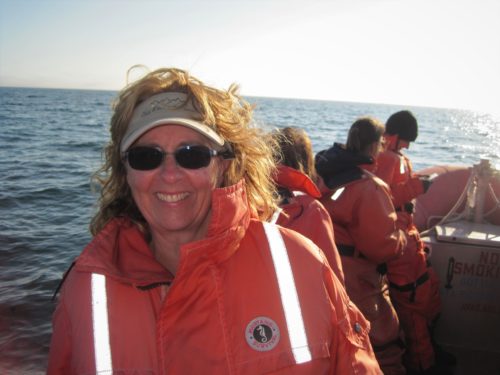
In the boat, floating on the Bay and watching for a sign
We ended up about 8-10 miles out before we saw our first Humpback whale. While it was all very exciting, I have to be perfectly honest and tell you that it was a bit anticlimatic after the tours we’ve been on in Alaska and Hawaii. In those places, the Humpbacks were very active – feeding together (circling the fish and making a bubble net), breaching (jumping out of the water), banging their tails on the surface or just sticking their noses up in the air (spy hopping). These whales were just ambling along, breathing, showing their backs and a couple of times a tail.
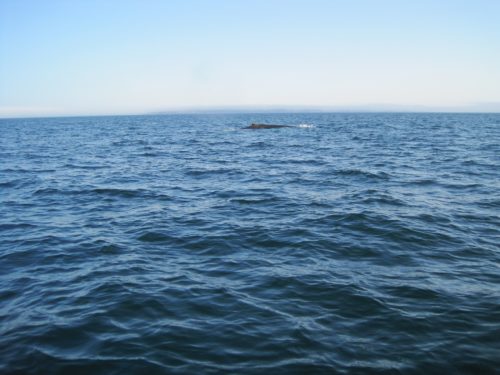
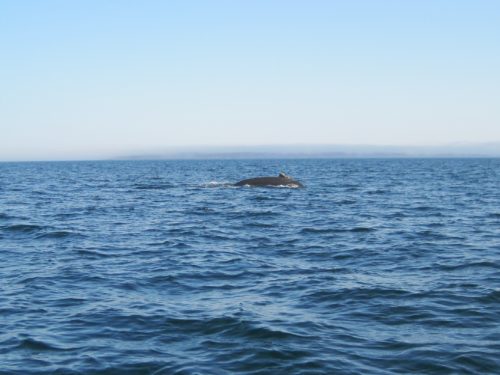
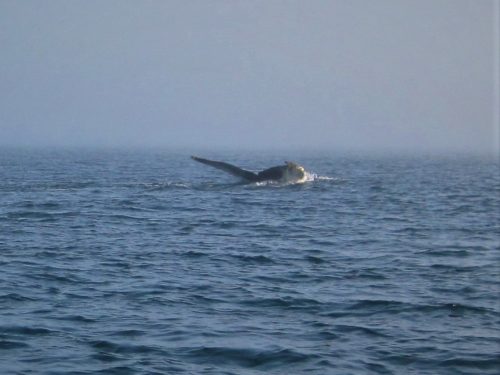
However – in Alaska and Hawaii, we weren’t level with them! So that made it more exciting! And in addition to the whales, we got to see Atlantic White-Sided dolphins frolicing in the water right beside us! Also, at their level! How fun! No pictures tho as they are just too fast!
Whenever we’d spot a ‘blow’ (whale breathing), we’d take off immediately and FAST, so you’d best be ready because Capt’n Tom waits for no one!
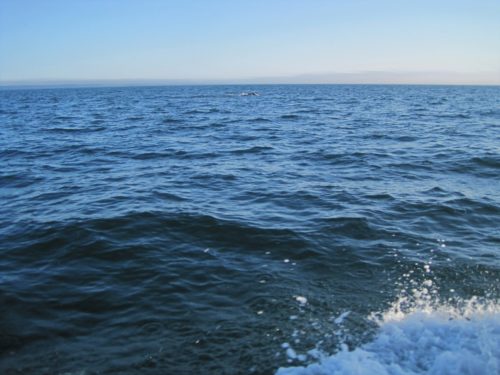
The other incredible part of the trip (in my humble opinion), was the onslaught of the evening fog. It was so cool to see the fog bank in the distance, a ‘fog bow’ (like a rainbow, but all fog and no color) and then to be out in the water and not be able to see in any direction!
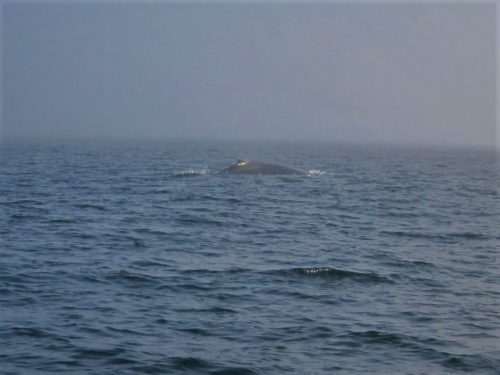
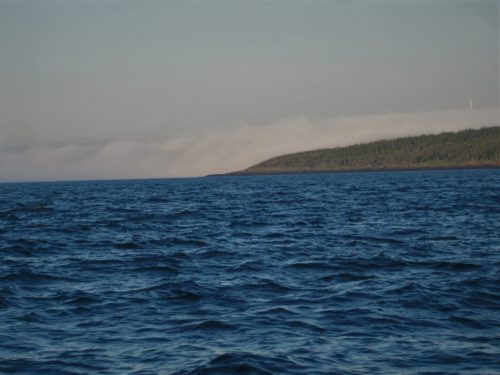
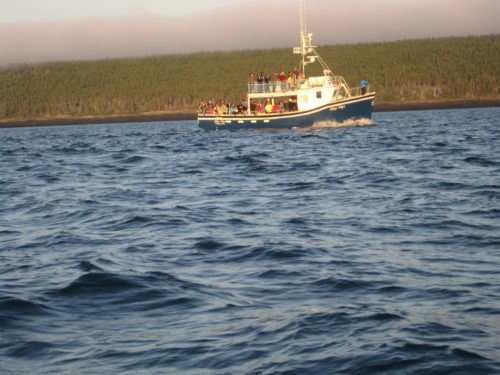
Another outfit looking for the elusive whales.
Having seen them, we were soooo glad we chose who we did!
We ran across more on our way back! Two together!
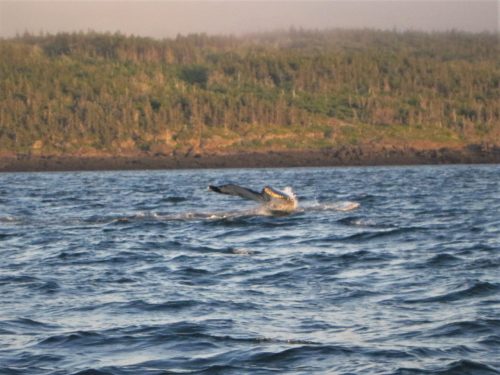
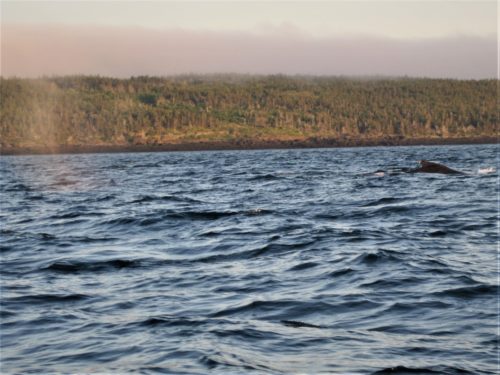
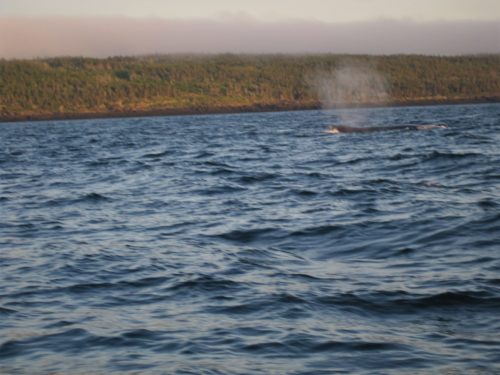
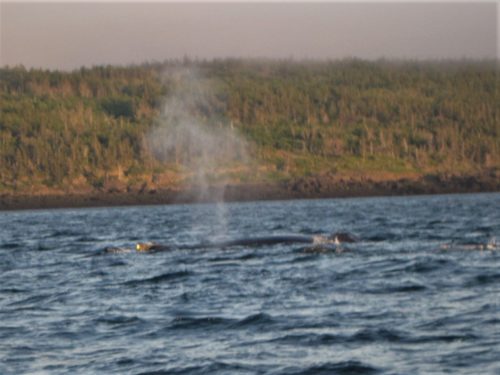
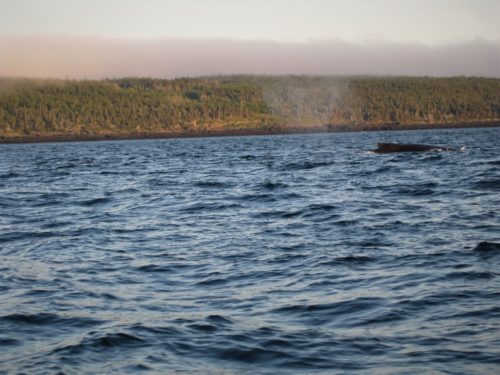
And just get a load of the sunset picture Blaine took!
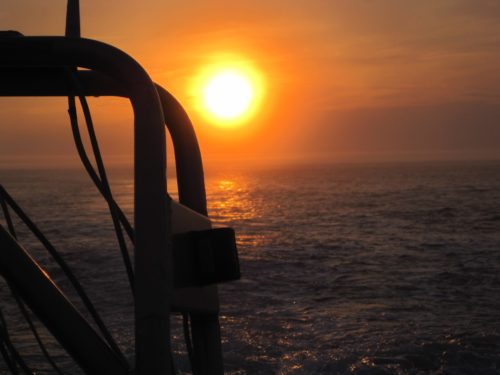
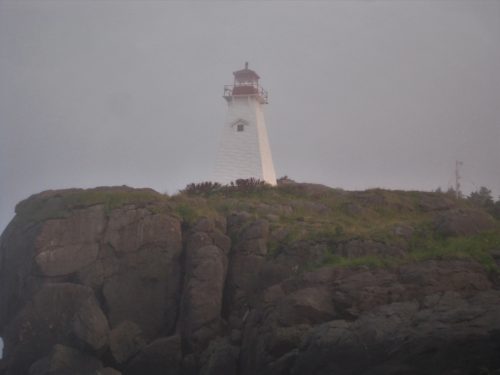
We passed this lighthouse on the way out and back
And then there were the chocolate dolphins. They make them themselves and had them all laid out on a platter that they took around to each person as we were disrobing. What a nice end to an incredible trip!
We had to wait about 30 minutes for the ferry. Everything looked so different in the fog at night!
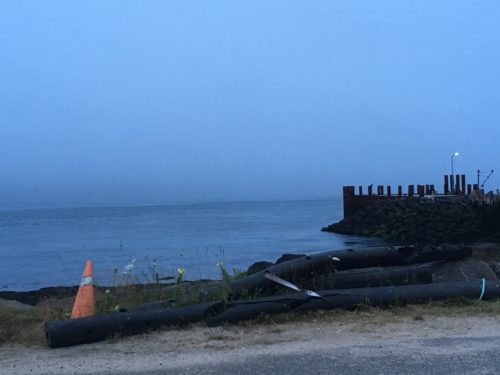
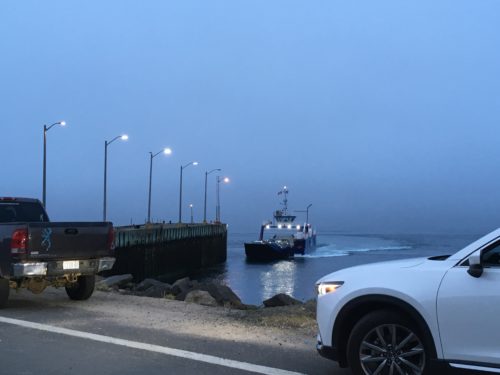
Stop #10 – home and bed! We actually slept in until 7am! Well, I never . . . .!!!
